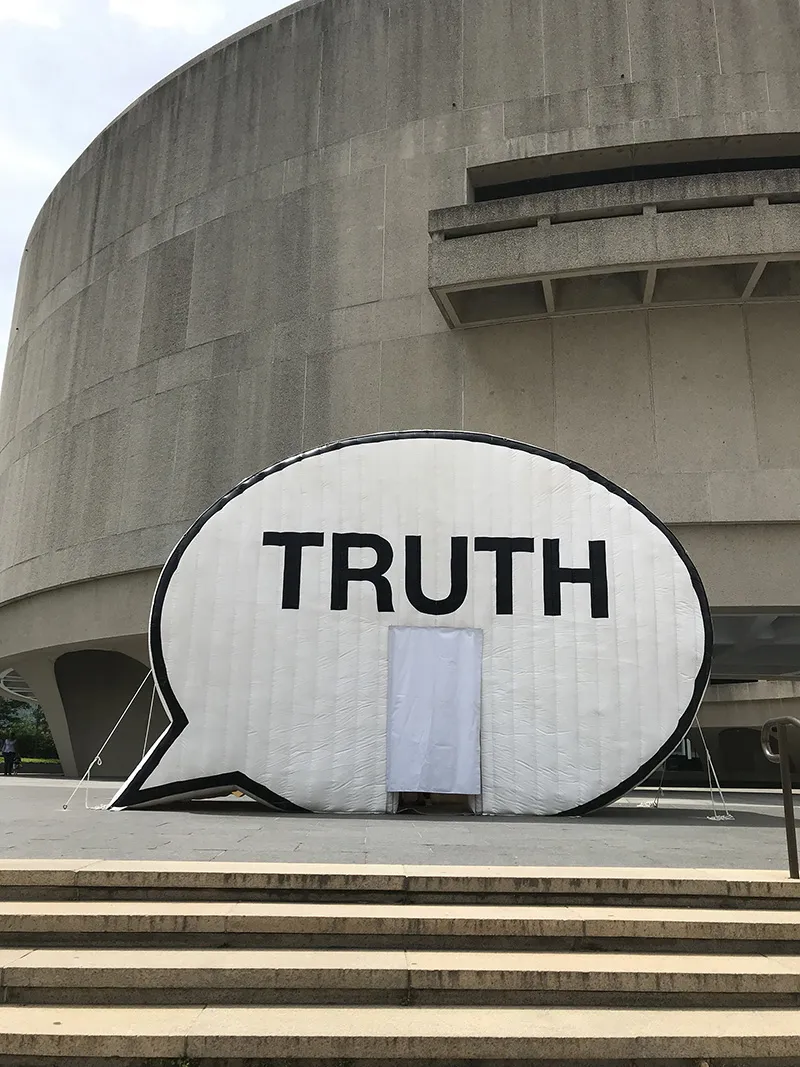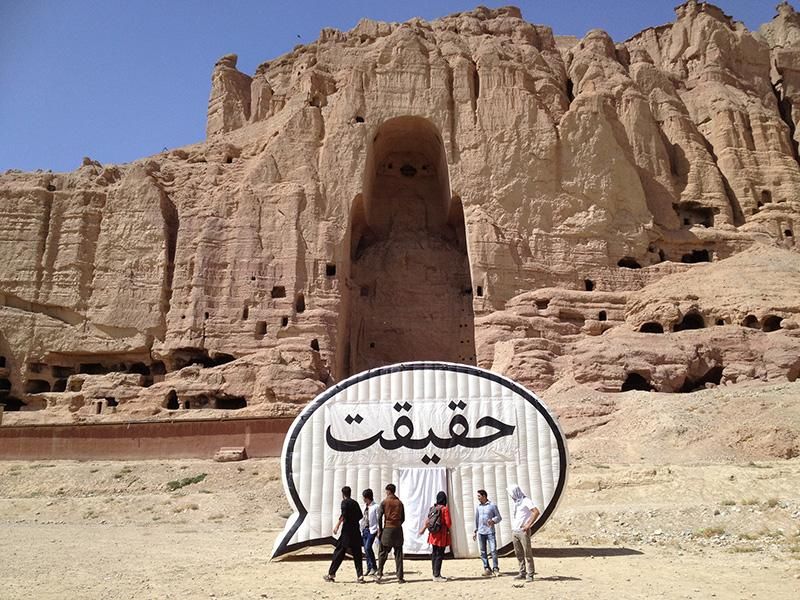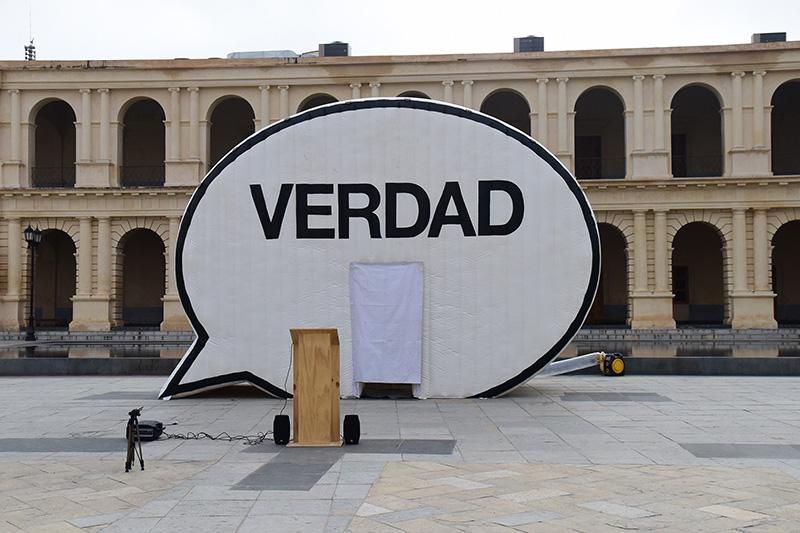A Globe-Trotting, Truth-Seeking Art Project Looks for Answers in D.C.
The Hirshhorn Museum hosts the ‘Truth Booth,’ a pop-up confessional where participants record honest reflections
/https://tf-cmsv2-smithsonianmag-media.s3.amazonaws.com/filer/0b/aa/0baa3208-57f9-4cae-9094-de54eb3c1601/truth_booth_main.jpg)
How do you define the truth? Artists in the Cause Collective weren’t sure—so they decided to trek all over the world and ask as many people as possible.
Over the better part of a decade, the group has traveled across the globe with their portable “Truth Booth,” an inflatable speech bubble that encases a miniature recording studio. They’ve collected thousands of answers to a seemingly simple prompt: “The truth is…”
What they’ve found is that the truth can be many things, says artist Jim Ricks, one of the project’s creators. Sometimes it means direct reflections on politics or free speech; other times, it’s an Afghan girl championing education, a woman forgiving her mother or a young Californian drawing attention to the drought (and his hatred of applesauce).
Now, In Search of the Truth (The Truth Booth) has arrived in the nation’s capital, where fact and fiction are often hotly debated. The installation will be parked on the Hirshhorn Museum’s outdoor plaza overlooking the National Mall from June 8 until June 23, inviting D.C. locals and visitors to come share their stories.
“I think it's important that the booth be here. This place has resonance and meaning,” says Jorge Sanchez, an adviser on The Truth Booth project. “To be a few feet away from the National Mall—a place where political things get decided, and people have had rallies that have been historic. For me, the truth is very personal, and yet it is also so politically powerful.”

The booth fits into the Hirshhorn’s current exhibition, “Manifesto: Art x Agency,” which examines how artists have engaged with political and social issues throughout history. As part of the exhibition, the Cause Collective will also be presenting a documentary on their recent tour through Mexico and highlighting a selection of videos from participants there.
Kevin Hull, the director of public engagement at the Hirshhorn, says his team envisioned the installation as a way to let visitors create their own personal manifestos like the art historical ones displayed in the rest of the exhibition. With its prominent location facing the mall, he says the booth has been an attention-grabber since the moment it was inflated; so far, he estimates the booth has seen around 300 people recording videos every day, with many more stopping by just to take a picture in front of it.
“For some people, a modern art museum can be an intimidating place,” Hull says. “We are always looking for ways to give people a chance to be active participants in what they’re looking at. Ultimately, we want people to see themselves as artists, or as creative citizens.”
According to Ricks, the “nascent idea” for The Truth Booth was born out of a couple earlier projects by the Cause Collective—a group of artists, designers and ethnographers creating public art projects. In 2008, the team presented statements on the truth in different languages for an installation at the University of California, San Francisco, and started thinking about how hard it was to directly translate the truth. For another project, the team was tasked with creating a “portrait of a city” for Oakland, California, and decided to compile short video snippets of Bay Area residents—much like the “self portraits” created in The Truth Booth, Sanchez says.
From those starting points, the Collective created In Search of the Truth (The Truth Booth), which they first presented in 2011 at an arts festival in Galway, Ireland. The design is straightforward: a white blowup speech bubble, cleanly outlined in black, with “TRUTH” marked out in all caps. Rather than feature one artist’s particular style, the team leaned into the more universal language of advertising, Ricks says.
“We wanted to really make it accessible and popular,” he says. “So it serves as a huge billboard—‘Speak the truth’—and maybe draws you to this more intimate, more personal exchange.”

The interior of the booth is a small and sparsely decorated space, almost like a confessional booth, Sanchez says. As participants record their clips, they’re watching themselves on the screen in real time. Something about the intimacy of being alone, looking into a virtual mirror, almost makes it feel like you’re talking to yourself and tends to bring out some deeply introspective answers, Ricks explains.
From Galway, the team made it their goal to cross the world in search of different perspectives. Since their initial tour of Ireland, they’ve brought The Truth Booth to Australia, Afghanistan, South Africa and more than 30 cities across the United States. Most recently, they loosely followed the routes of migrants making their way toward the U.S. in a tour that began in southern Mexico, journeyed up through the border in El Paso and ended in Los Angeles.
Though there are trends that show up in “truths” collected at specific places or moments—many participants in Mexico spoke on the realities of the immigration crisis, for example, and during the U.S. election in 2016 lots of videos had a political spin—Sanchez says he’s also been interested to discover links between truths that are distant in space and time.
“There's a ‘eureka’ moment when I see a truth that was taken in Australia, and a truth that was maybe taken in Alabama, and they mirror each other, or they contradict each other, but there's certainly dialogue between these truths of two people who may never ever meet,” Sanchez says. “So there's a kind of magic to the truth.”

Even when the tours are planned out to tell a specific story, like the migratory journey through Mexico, Ricks says he likes to leave some room for impromptu stops. Luckily, the booth was designed to be portable; although it takes a little elbow grease to break it down, the entire setup can be compressed into a manageable bundle. (Sanchez likes to refer to the process—which consists of “deflating the truth,” folding it like a burrito and then rolling it up like a sleeping bag—as the “closing ceremony” for each site.)
And just a little bit of distance can transform the way people interpret and react to the booth: Sanchez recalls how the project became a political “raised fist” at one spot right on the U.S.-Mexico border as patrol agents constantly drove past the site, while a few miles down the road, when they set up in a baseball diamond in a working-class Mexican community, the focus became all about kids playing and people going about their daily lives.
The team still has a lot of ground to cover for a truly global perspective, Ricks says. They’re heading back to Australia in the fall and later have plans to visit St. Louis, with a potential stop in Ferguson, Missouri, five years after protests erupted there over the fatal police shooting of Michael Brown.
While he set out expecting more of the truths to involve people’s takes on current events, Ricks says he’s been surprised by the wide range of responses. He says he hopes the booth provides a space that can empower people in speaking their own truths, whatever they may be.
“So many people often ask, you know, ‘I don't have anything good to say, what's a good truth?’ A good truth is an original one,” Ricks says. “You can tell when people are being truthful, no matter what language they're speaking. You can see it in their eyes.”
/https://tf-cmsv2-smithsonianmag-media.s3.amazonaws.com/accounts/headshot/Maddie_3.jpg)
/https://tf-cmsv2-smithsonianmag-media.s3.amazonaws.com/accounts/headshot/Maddie_3.jpg)